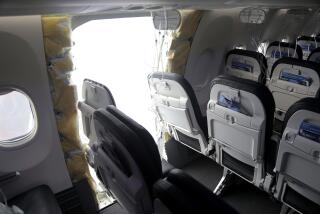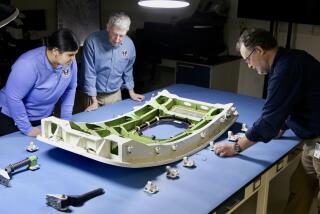Jet Crash Inquiry Shifts to Tail Section Breakup
- Share via
NEW YORK — The investigation into the crash of American Airlines Flight 587 into a neighborhood in Queens shifted Tuesday from a possible engine failure to an unexplained breakup of the tail section, officials said, raising new questions about the disaster that killed at least 265 people.
Aviation safety investigators from the National Transportation Safety Board are now trying to understand why critical components such as the plane’s tail fin fell half a mile from the fuselage wreckage. Also, both engines were found several hundred feet from the main debris field.
“This is a far more perplexing case than people imagined,” said aviation consultant Peter Goelz, former managing director of the NTSB. However, officials said the evidence continues to point to an accident, and not a crime or another terrorist attack.
The tail fin--which helps to keep a plane flying straight--was pulled Monday from the waters of Jamaica Bay and appeared as if it had cleanly broken away from the rest of the fuselage. Without the fin, it would be virtually impossible for pilots to maintain control. Officials said initial analysis points to a fracture of the material used to make the tail fin, not the bolts attaching it to the main fuselage.
Witnesses “saw the aircraft wobble, pieces come from it, and then a steep spiraling dive into the ground,” said NTSB member George Black.
Another element was added to the puzzle Tuesday when NTSB officials said they were investigating whether the turbulent wake of a Japan Air Lines Boeing 747 could have played a role. The larger jet had taken off two minutes and 20 seconds earlier and was seven to eight miles ahead of the smaller American Airlines Airbus 300.
The time and distance should have been more than enough to forestall any problems, but the cockpit voice recorder on Flight 587 picked up comments indicating that the pilots encountered turbulence.
Asked if wake turbulence could have been a factor, Black responded, “It’s possible.” Pressed on whether it could have torn off the tail section, he added: “That is certainly one thing that we want to know.”
American Airlines spokesman John Hotard was less equivocal. “Terrific forces tore off a tail and apparently the plane’s two engines,” he said.
Despite the lack of an immediate explanation for the crash, there was no suggestion from the NTSB or the FBI that Flight 587 was brought down by a bomb or some other criminal act.
“Everything that we have seen thus far indicates that this was an accident,” said NTSB Chairwoman Marion C. Blakey.
In what Blakey called a “major breakthrough,” investigators on Tuesday recovered the plane’s second “black box”--the flight data recorder--which should contain critical details on how the pilots worked the controls and other technical aspects of the flight.
Most of the remains of the victims have been recovered from the site of the fiery wreck, allowing the investigation to proceed unhindered, she said.
NTSB member Black told reporters that the cockpit voice recorder, recovered on Monday, picked up sounds of an “airframe rattling noise” after Flight 587 took off Monday without incident and was climbing away from John F. Kennedy International Airport, bound for Santo Domingo, Dominican Republic, in the Caribbean.
The initial sound of shaking from the fuselage came one minute and 47 seconds after the plane had powered up for takeoff. Up to that time, nothing on the recording indicated anything was awry, based on a preliminary analysis, Black said.
About seven seconds after the rattling sound, the recorder picked up a comment from Capt. Edward States about wake turbulence from the jet ahead. Another seven seconds later, the rattling noise was heard again. It was quickly followed by the voice of co-pilot Sten Molin, who was flying the takeoff, calling for more power from the jet’s two engines.
Then, two minutes and seven seconds after the plane began taxiing for takeoff, the cockpit voice recorder picked up comments from the pilots indicating that they were losing control.
The recording ended 17 seconds later.
Black said the investigation thus far has shown no signs of a catastrophic engine failure, despite early suspicions based on prior problems with the type of engine on the Airbus. He said, however, that no final conclusions have been reached.
He also discounted speculation that an engine could have failed by sucking in birds, which have posed a safety problem on JFK’s runways. “There is no evidence of any kind of foreign object damage--including a bird,” he said.
New concerns focused on the Airbus tail fin--known as the vertical stabilizer--and on the still-undetermined role of turbulence.
“If the vertical stabilizer broke off as part of the accident sequence, that is a whole new problem,” said a former government air crash investigator who asked not to be identified. “That is strong structure--like a wing. Those things are never supposed to happen. If I were American Airlines, I would be inspecting the attachment fitting for all the vertical stabilizers.”
Asked if he could explain why the tail fin broke off, Black responded: “Call back in about a year and we’ll tell you.”
On Tuesday, investigators recovered Flight 587’s rudder, which is part of the tail fin assembly and was used to help steer the jet. The rudder had also landed in Jamaica Bay.
The NTSB said the rudder was trimmed to a left deflection of 10 degrees, and Barry Schiff, a retired Boeing 747 captain and air safety consultant, said this appeared to indicate that the right engine had failed.
Airbus spokesman Mark Luginbill declined to comment on the investigation.
Among the reasons a stabilizer could break off are a sudden structural failure, improperly tightened bolts in the course of maintenance, or sabotage. However, since the bolts remained secured to the main fuselage, suspicion focused on the first possibility, a structural breakdown.
Officials said the vertical stabilizer cracked above its attachment point to the fuselage, while the bolts that were supposed to hold it in place remained intact. They speculated that the problem might be some weakness in the material--a combination of aluminum and a composite material.
The Federal Aviation Administration issued two airworthiness directives in 1998 and 1999 mandating inspections or repairs to the A300 vertical stabilizer or rudder. However, both dealt with rudder control mechanisms, not structural issues.
Another, not applicable to the Airbus 300-600 series, mandated visual inspection for “fatigue-related cracking, which could result in reduced structural integrity of the fuselage, wing, and vertical stabilizer.” That directive was issued in 1998.
The role of turbulence may be even more difficult to pin down.
Large airplanes leave strong air currents in their wake. Called “wake vortices,” they are often likened to small, horizontal tornadoes. Wake vortices can cause pilots, particularly on small planes, to lose control. But it would be highly unusual for a large jet like an Airbus 300 to break apart due to an encounter with wake turbulence.
The new information from the NTSB left veteran pilots at a loss to explain the catastrophe.
*
Times staff writer Richard O’Reilly and researcher Robert Patrick contributed to this report.
(BEGIN TEXT OF INFOBOX / INFOGRAPHIC)
Final Moments in Cockpit
The final moments of American Airlines Flight 587, according to a preliminary outline provided by the National Transportation Safety Board and based on data from the cockpit voice recorder:
Time*: 1:47
Transmission: Rattle from the aircraft’s frame is heard.
*
Time*: 1:54
Transmission: Captain makes a comment about wake turbulence.
*
Time*: 2:01
Transmission: Second rattling noise from the aircraft frame is heard.
*
Time*: 2:05
Transmission: The co-pilot, who is flying the plane, calls for maximum power.
*
Time*: 2:07
Transmission: Several comments begin suggesting pilots are losing control of the aircraft.
*
Time*: 2:24
Transmission: Cockpit voice recording ends.
*
*Minutes into flight
More to Read
Inside the business of entertainment
The Wide Shot brings you news, analysis and insights on everything from streaming wars to production — and what it all means for the future.
You may occasionally receive promotional content from the Los Angeles Times.










